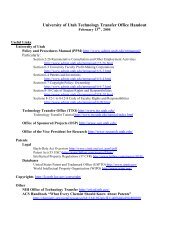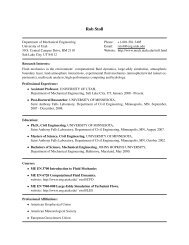Concept Selection Facts About Concept Selection
Concept Selection Facts About Concept Selection
Concept Selection Facts About Concept Selection
Create successful ePaper yourself
Turn your PDF publications into a flip-book with our unique Google optimized e-Paper software.
<strong>Concept</strong> Development Funnel<br />
concept generation<br />
concept screening<br />
concept scoring<br />
concept testing<br />
ME EN 4000 – Engineering Design I – <strong>Concept</strong> <strong>Selection</strong> 5<br />
<strong>Selection</strong> Methods (contd.)<br />
• Multivoting. Each member of the team votes for a set<br />
number of projects.<br />
– Maybe: Depends on how objectively the team members vote..<br />
• Pros and cons. The team lists strengths and<br />
weaknesses of each concept and makes a choice based<br />
upon group opinion.<br />
– Yes: The decision is group based and (presumably) objective.<br />
• Prototype and test. The organization builds and tests<br />
prototypes of each concept, making a selection based<br />
upon test data.<br />
– No: Too costly for hundreds of concepts.<br />
– Yes: Final concept selection.<br />
Source: Ulrich K, Eppinger S, Product Design and Development<br />
ME EN 4000 – Engineering Design I – <strong>Concept</strong> <strong>Selection</strong> 7<br />
<strong>Selection</strong> Methods<br />
• External decision. <strong>Concept</strong>s are turned over to the<br />
customer or other external entity.<br />
– No: Customer should not be bothered with hundreds of<br />
concepts.<br />
– Maybe: Final concept selection.<br />
• Product champion. An influential member of the<br />
product development team chooses a concept based on<br />
personal preference.<br />
– No: Group consensus is preferable both for confidence and<br />
harmony.<br />
• Intuition. The concept is chosen by its feel. No explicit<br />
criteria are used. The concept simply seems better.<br />
– No: Design decisions need to be objective and justifiable.<br />
Source: Ulrich K, Eppinger S, Product Design and Development<br />
ME EN 4000 – Engineering Design I – <strong>Concept</strong> <strong>Selection</strong> 6<br />
<strong>Selection</strong> Methods (contd.)<br />
• Decision matrices. The team rates each concept<br />
against pre-specified selection criteria, which may be<br />
weighted.<br />
– Yes: Preferred method.<br />
Source: Ulrich K, Eppinger S, Product Design and Development<br />
ME EN 4000 – Engineering Design I – <strong>Concept</strong> <strong>Selection</strong> 8





